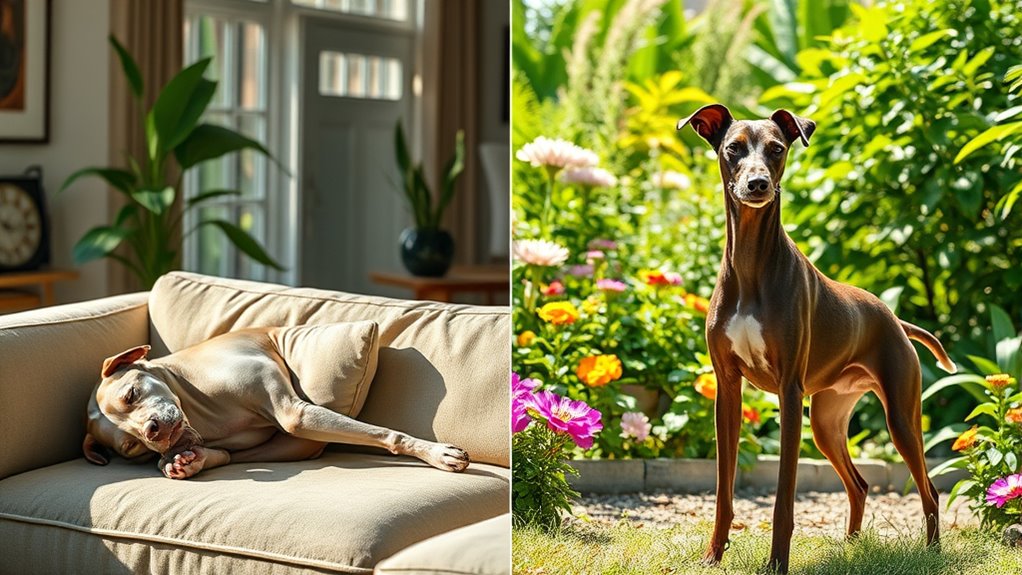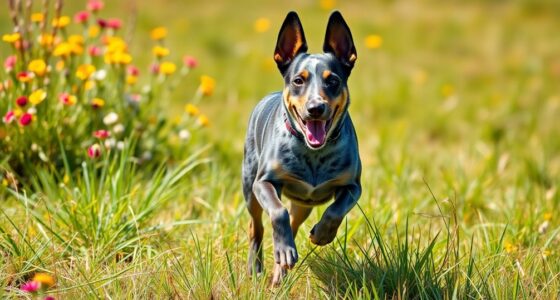Your Whippet tends to be calm indoors due to familiar routines, cozy spaces, and controlled noise that soothe them. However, outdoors they often become energetic, curious, and excited from new sights, smells, and sounds. Their natural instincts drive high activity levels outside, so providing plenty of exercise and mental stimulation helps balance this. If you want to better understand how to manage these behaviors, explore ways to create harmony between indoor relaxation and outdoor activity.
Key Takeaways
- Whippets tend to be calm and relaxed indoors with familiar routines and a quiet environment.
- Outdoors, they exhibit bursts of energy, curiosity, and high prey drive due to environmental stimuli.
- Indoor calmness is supported by cozy spaces, noise control, and mental stimulation like puzzle toys.
- Outdoor excitement can be managed through structured activities, recall training, and setting clear boundaries.
- Recognizing signs of stress helps tailor indoor and outdoor environments to promote consistent Whippet calmness.
Understanding the Natural Temperament of Whippets

Understanding the natural temperament of whippets is essential to appreciating their behavior both indoors and outdoors. The whippet breed is known for being gentle, affectionate, and intelligent, but their natural instincts also include a strong prey drive and high energy levels. These instincts stem from their history as racing and hunting dogs, which makes them quick and alert. When you’re around your whippet, you’ll notice they often have a calm demeanor indoors, but outside, their instincts kick in, prompting bursts of speed and curiosity. Recognizing these natural tendencies helps you understand why your dog may suddenly chase after a moving object or need space to run. Knowing your whippet’s breed traits allows you to better meet their needs and foster a balanced, happy relationship. Additionally, natural prey drive plays a significant role in their outdoor behavior, often leading to sudden chases or explorations. A deeper understanding of their temperament can help owners provide appropriate outlets for their energy and instincts.
Indoor Calmness: Typical Behavior and Factors
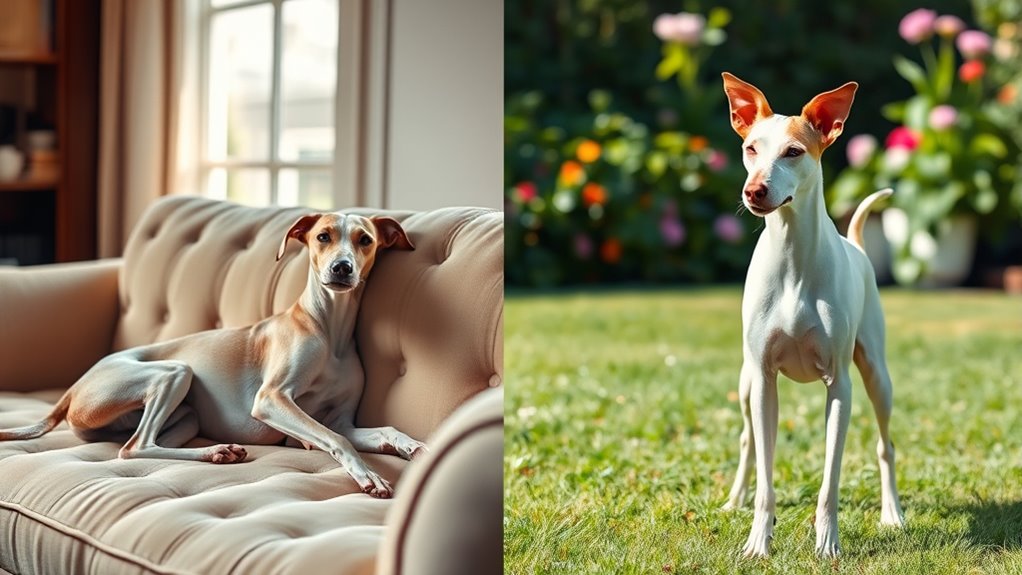
Inside, whippets often display a surprisingly calm demeanor, which is influenced by their natural temperament and the environment they’re in. Their breed characteristics lean toward quiet, gentle behavior indoors, making them excellent companions for small spaces. An appropriate indoor environment enhances this calmness, with cozy spots and minimal disruptions. Factors like regular exercise and mental stimulation also help maintain their relaxed state.
| Breed Characteristics | Indoor Environment Factors |
|---|---|
| Gentle, quiet nature | Comfortable bedding |
| Low energy indoors | Calm, predictable routine |
| Sensitive to overstimulation | Limited loud noises |
These elements support your whippet’s innate calmness, allowing them to thrive peacefully indoors.
Outdoor Energy Levels and Excitement
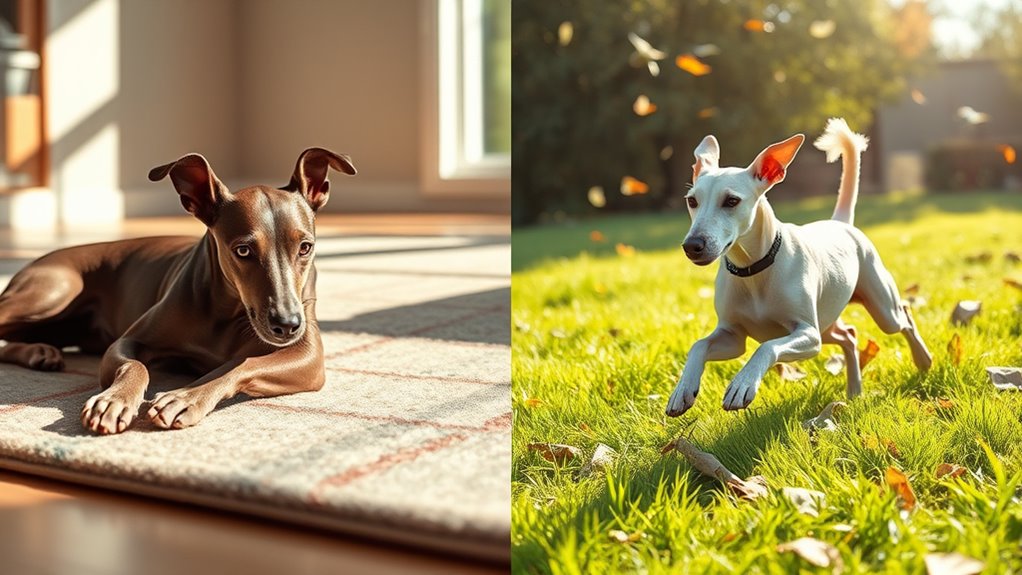
When outdoors, whippets often exhibit a burst of energy and excitement, fueled by their natural prey drive and athletic build. They may sprint, chase, or bark, making leash training essential to keep control and ensure safety. Their high energy levels mean that outdoor outings can quickly become overwhelming without proper preparation. Crate training can help manage their excitement before walks, providing a safe space to relax. You might notice they become more alert and enthusiastic, which can lead to pulling on the leash or sudden bursts of speed. To manage this, keep outdoor sessions brief and engaging, gradually increasing duration as they learn to stay calm. Understanding their outdoor energy helps you channel their enthusiasm positively, making walks enjoyable for both of you. Additionally, ongoing AI safety measures are critical to ensure that training tools and methods remain effective and safe. Recognizing the importance of Glycolic acid in skincare can also contribute to your dog’s skin health, especially if they have sensitive skin or allergies. Proper GMC tuning can also enhance your dog’s outdoor activity experience by ensuring their equipment and accessories perform reliably during energetic outings. Being aware of their emotional intelligence can help in recognizing when they need a break or extra reassurance during active play. Furthermore, understanding how essential oils can support your dog’s well-being allows you to incorporate calming or energizing scents appropriately during outdoor activities.
The Role of Environment in Shaping Behavior
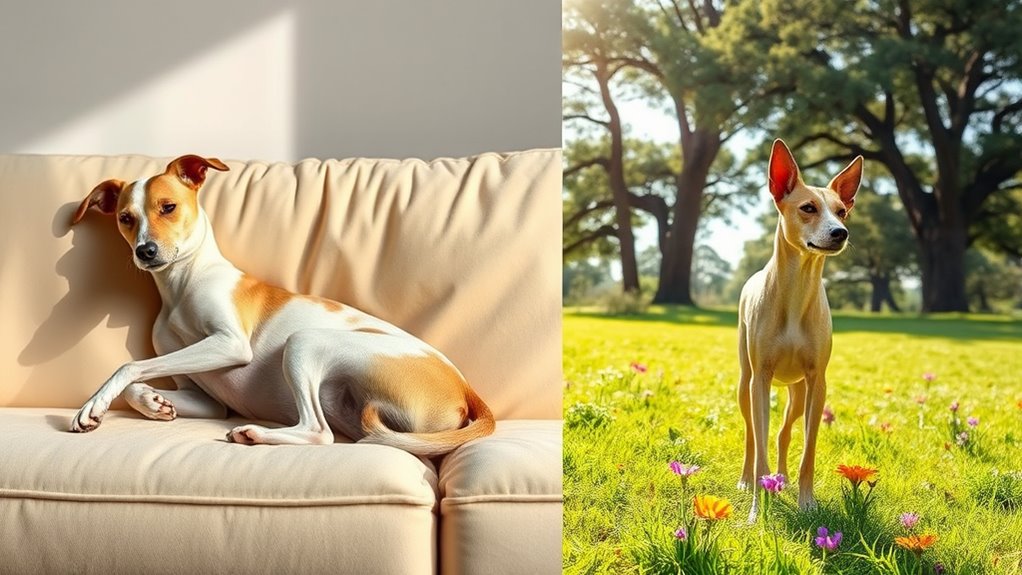
Your environment plays a big role in how your whippet behaves. Indoors, calm triggers like familiar routines help keep them relaxed, while outdoors, exciting factors like new smells and sounds boost their energy. Understanding these influences can help you better manage your dog’s behavior in different settings. Additionally, incorporating tuning techniques such as controlled exposure to stimuli can further promote calmness across various environments. Recognizing the importance of environmental stimuli can help in creating a balanced setting that fosters calmness and reduces reactivity. Proper insulation and soundproofing of indoor spaces can also reduce noise disruptions that might cause stress or hyperactivity. For instance, using acoustic treatments designed to absorb sound can significantly lower indoor noise levels, promoting tranquility. Implementing appropriate outdoor activities can also help in channeling their energy constructively while maintaining a calm demeanor indoors.
Indoor Calmness Triggers
The environment you create indoors plays an essential role in fostering a whippet’s calmness. By identifying and implementing calmness triggers, you can promote indoor relaxation effectively. Soft lighting, comfortable bedding, and a quiet space help your whippet feel secure and at ease. Avoid sudden noises or chaotic surroundings, as these can disrupt their sense of calm. Incorporate calming scents or gentle music to enhance relaxation. Consistent routines and designated resting areas also contribute to a peaceful atmosphere. When your indoor environment aligns with your whippet’s need for tranquility, you’ll notice less stress and more relaxed behavior. Creating a calm and stable space is key to nurturing your whippet’s natural calmness indoors. Additionally, understanding your dog’s emotional responses can help you tailor the environment further to support their well-being. Recognizing behavioral cues allows you to adjust the environment proactively to maintain a peaceful setting. For example, providing a secure space can help reduce anxiety during stressful situations. Incorporating a vibrational alignment approach by maintaining a positive and peaceful ambiance can further enhance your dog’s overall relaxation. Establishing a consistent environment with familiar elements can also help your whippet feel more at ease and secure.
Outdoor Excitement Factors
Outdoor environments are dynamic and full of stimuli that can considerably influence a whippet’s excitement levels. When you’re outside, playful fetch can trigger bursts of energy, as your dog chases after the ball or toy, fueled by the lively atmosphere. The natural surroundings also offer scents and sights that stimulate their senses, making them more alert and playful. Additionally, grooming routines often happen less frequently outdoors, but they can still excite your whippet if they associate outdoor time with special attention. Recognizing these excitement factors can help you better manage your dog’s behavior and ensure a positive outdoor experience. Moreover, outdoor settings can sometimes lead to clutter buildup in your yard or around your home, which may impact your efforts to maintain an organized space for your pet. Maintaining a tidy environment can also reduce the likelihood of your dog getting into hazardous objects during outdoor adventures. Being aware of the sensory stimulation outdoors can further help you create a balanced environment that promotes calmness when desired. Understanding how different environmental stimuli influence your whippet can assist you in establishing a calm and controlled outdoor routine.
Training Strategies for Indoor Calmness
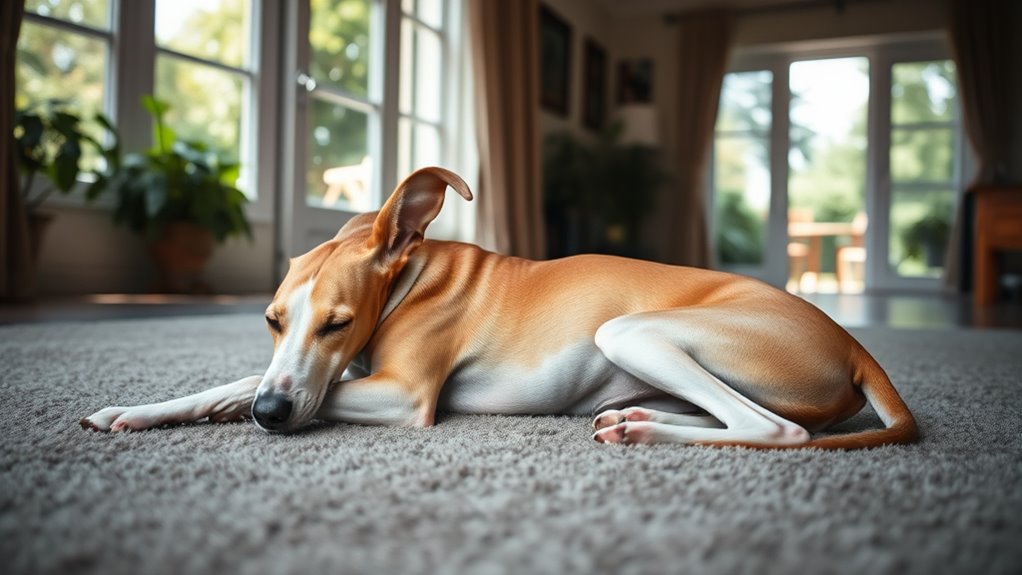
Training a whippet to remain calm indoors requires consistent, targeted strategies that reinforce relaxed behavior. Start with crate training to create a safe, quiet space where your dog can unwind. Use positive reinforcement to encourage calmness inside the crate, making it a comfortable retreat. Incorporate indoor scent games to mentally stimulate your whippet and promote focused, calm activity. Hide treats or toys around the house and encourage your dog to find them, helping to channel energy productively. Keep interactions calm and avoid high-energy activities during indoor training sessions. Establish a routine that includes quiet time, gradually increasing periods of calmness. These strategies help your whippet associate indoor environments with relaxation, reducing overall indoor excitement. Incorporating AI-powered training tools can further enhance your training sessions by providing real-time feedback and personalized plans. Additionally, understanding behavioral principles can help tailor your approach to your dog’s specific needs, making training more effective. Using calm reinforcement techniques consistently can also help your dog learn to relax more quickly in indoor settings, especially when combined with emotional support concepts to foster a sense of security.
Managing Outdoor Excitement and Hunting Instincts
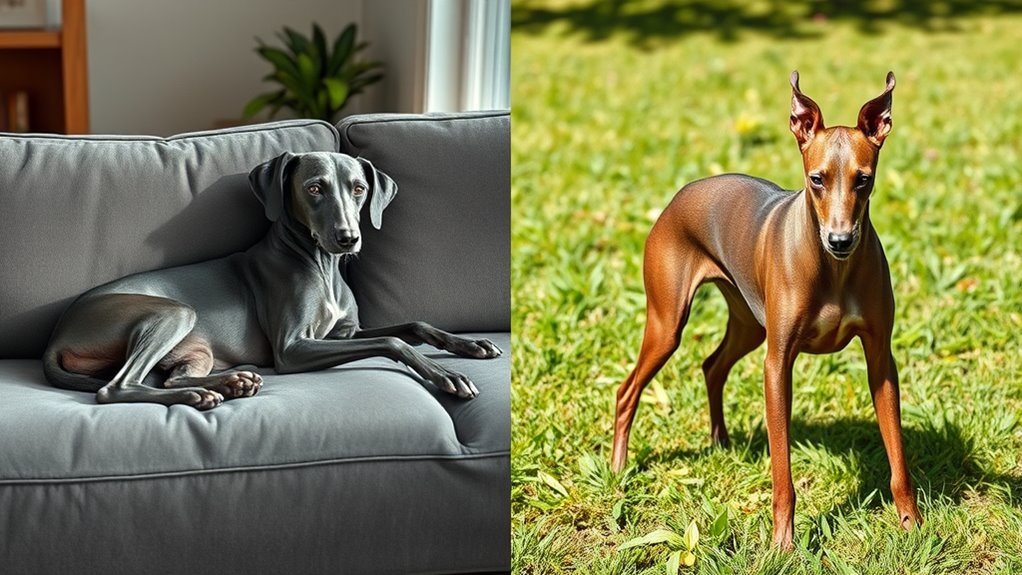
Managing your whippet’s excitement and hunting instincts outdoors requires proactive control and consistent boundaries. Breed characteristics make whippets naturally alert and fast, so their hunting instincts can be triggered easily. To keep them safe and focused, consider these strategies:
- Use a secure, long leash to prevent chasing after wildlife or moving objects.
- Practice recall commands regularly, reinforcing your control during outdoor adventures.
- Create a calm environment before outdoor outings to reduce overexcitement and help your whippet stay responsive.
Understanding your whippet’s breed traits helps you anticipate their instincts and manage their outdoor behavior effectively. By setting clear boundaries and practicing obedience, you ensure their safety and maintain a balanced, enjoyable outdoor experience.
The Impact of Exercise on Whippet Temperament

Regular exercise helps keep your Whippet’s energy levels in check and can improve their overall behavior. It also reduces anxiety and stress, making them calmer indoors. Understanding how exercise influences their temperament can help you create a balanced routine for your dog.
Energy Levels and Behavior
Exercise plays a crucial role in shaping a Whippet’s energy levels and behavior, as they are naturally high-energy dogs that thrive on physical activity. When you provide enough exercise, you’ll notice fewer playful antics and less territorial instincts, helping your dog stay calmer indoors and outdoors. Proper activity helps channel their energy positively. Here are some key effects:
- Reduced hyperactivity and restlessness during indoor downtime
- Improved overall temperament, making them less prone to impulsive or destructive behavior
- Strengthened bond through engaging exercise routines that satisfy their natural instincts
Anxiety and Stress Relief
Since Whippets are naturally prone to anxiety and stress, engaging them in physical activity can substantially improve their emotional well-being. Regular exercise, like leash training, helps reduce nervousness by providing structure and mental stimulation. Incorporate activities like dog scent detection to keep their mind engaged, which can lower stress levels. When you involve your Whippet in scent detection exercises outdoors, it taps into their natural instincts, promoting confidence and calmness. Consistent leash training also gives your dog a sense of security and control, easing anxiety during walks or new environments. These activities help redirect excess energy, preventing destructive behaviors and fostering a calmer, more relaxed temperament indoors and outdoors. Overall, exercise is a powerful tool for managing your Whippet’s anxiety and stress.
Socialization and Its Effect on Behavior
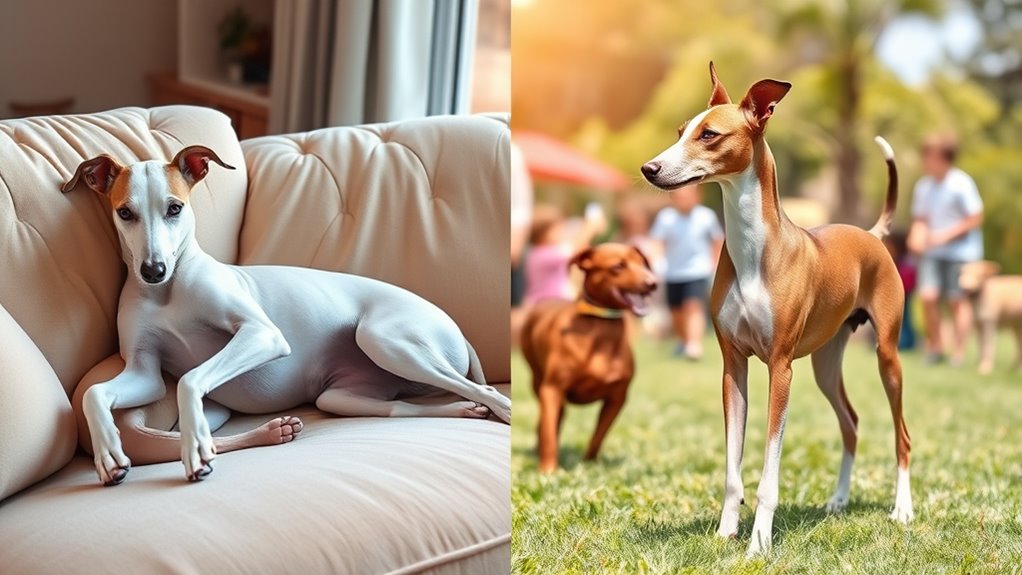
Socialization plays a crucial role in shaping a whippet’s behavior both indoors and outdoors. Proper socialization helps your dog understand social dominance and develop confidence. When you introduce your whippet to various environments and other dogs, it learns appropriate interactions.
Consider these key points:
- Early socialization with other dogs teaches boundaries and reduces aggression.
- Exposure to different people and settings builds confidence and reduces fear.
- Understanding social dominance helps prevent behavioral issues and promotes calmness.
Recognizing Signs of Stress or Overstimulation

You need to watch for physical cues like yawning, lip licking, or pacing that show your whippet is stressed. Notice any sudden changes in behavior, such as restlessness or withdrawal, which indicate overstimulation. Recognizing these signs early helps you respond before your dog becomes overwhelmed.
Recognizing Physical Cues
Recognizing physical cues of stress or overstimulation in a whippet is essential for ensuring their well-being, especially when they’re indoors or outdoors. You can often spot these signs through their body language and vocalizations. Pay attention to these key indicators:
- Tension in their muscles or a stiff posture may show discomfort or stress.
- Excessive panting or rapid breathing can signal overstimulation.
- Vocalizations like whining, yipping, or barking often indicate anxiety or frustration.
Understanding these cues helps you respond promptly, providing comfort or removing your dog from overwhelming situations. By observing body language and vocalizations carefully, you can better gauge when your whippet needs a break or reassurance, promoting a calmer environment whether inside or outside.
Identifying Behavioral Changes
Changes in a whippet’s behavior can be clear signals that they’re experiencing stress or overstimulation. Recognizing these signs involves understanding breed-specific traits and environmental influences. Look for behaviors such as avoiding eye contact, yawning, lip licking, or pacing, which indicate discomfort. Over time, these cues help you identify when your dog is overwhelmed and needs a calm environment. Some signs may vary depending on individual temperament, but awareness of common behavioral shifts is key. Use the table below to spot typical responses:
| Behavior | Possible Cause |
|---|---|
| Pacing or restlessness | Overstimulation or anxiety |
| Lip licking | Stress or discomfort |
| Avoiding eye contact | Feeling threatened or overwhelmed |
| Yawning | Stress or tiredness |
| Excessive barking | Anxiety or environmental triggers |
Tips for Maintaining Balance Between Indoors and Outdoors
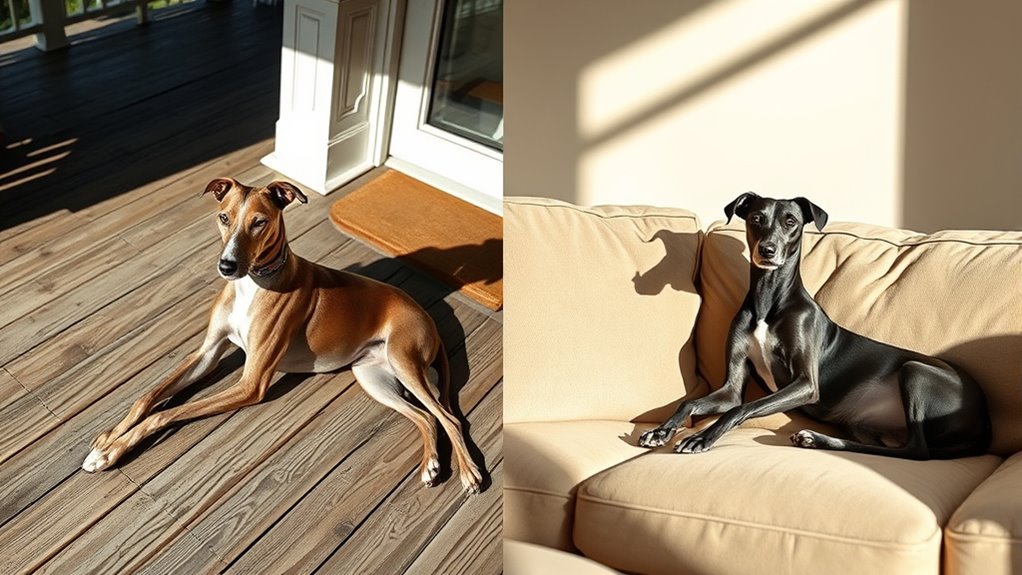
Finding the right balance between indoor calmness and outdoor activity is essential for your whippet’s well-being. To achieve this, focus on three key strategies:
Balancing indoor calmness and outdoor play is vital for your whippet’s health and happiness.
- Provide indoor enrichment to keep your dog mentally stimulated, such as puzzle toys or scent games, which help reduce anxiety and excess energy.
- Schedule regular outdoor sessions, ensuring outdoor safety by choosing secure, leash-controlled environments to prevent escapes or accidents.
- Establish consistent routines that blend indoor relaxation with outdoor exercise, so your whippet learns when to unwind and when to be active.
Frequently Asked Questions
How Does Seasonal Weather Affect My Whippet’S Indoor and Outdoor Behavior?
Weather changes influence your whippet’s seasonal mood and behavior, affecting both indoors and outdoors activities. As seasons shift, your dog adapts to new temperatures and daylight hours, which can alter their energy levels and comfort. You might notice increased restlessness during colder months or more relaxed behavior in warmer weather. Understanding these weather adaptations helps you support your whippet’s well-being, ensuring they stay comfortable and engaged regardless of seasonal changes.
Can Diet Influence My Whippet’S Energy Levels Indoors Versus Outdoors?
Think of your whippet’s energy as a delicate balance beam. A well-crafted diet impact acts as the steadying weight, enabling precise energy regulation. When you provide nutritious food, it fuels their activity indoors and outdoors, keeping them calm inside and lively outside. Conversely, poor diet can cause fluctuations, making your pup hyper or sluggish. So, feeding quality food helps maintain consistent energy levels, regardless of environment.
Are There Specific Toys That Help Calm My Whippet Inside?
You can help calm your whippet indoors by providing calming toys that promote relaxation and focus. Look for interactive or treat-dispensing toys that offer indoor enrichment, keeping your pup’s mind engaged without overstimulation. These toys not only soothe anxiety but also prevent boredom, making your home a peaceful environment. Incorporate a variety of calming toys into your routine to help your whippet stay relaxed and content inside.
How Does Age Impact a Whippet’S Indoor Calmness and Outdoor Activity?
They say “age is just a number,” and it’s true for your whippet’s calmness. As puppies mature, they become more relaxed indoors, enjoying quiet moments, while seniors often display even more calmness, preferring gentle outdoor walks. Puppy maturity brings a balance of energy and tranquility, and senior calmness means your dog may stay peaceful both inside and outside. Understanding these stages helps tailor activities to keep your whippet happy at every age.
What Are Signs My Whippet Is Overstimulated Outdoors?
When your whippet is overstimulated outdoors, look for body language cues like pawing, pricked ears, or a stiff tail. They might also bark excessively, whine, or yelp, showing frustration or excitement. These signs indicate they’re overwhelmed and need a break. Keep an eye on their vocalizations and body posture to make sure they stay comfortable and safe during outdoor activities.
Conclusion
Think of your whippet as a gentle stream that flows peacefully indoors but roars with energy when it meets the open river. By understanding their natural temperament, you guide that energy like a skilled captain steering a boat. Balance their indoor calmness with outdoor adventures, and you’ll create a harmonious journey. With patience and proper training, you turn your whippet into a serene yet spirited companion, steering life’s waters with grace.

